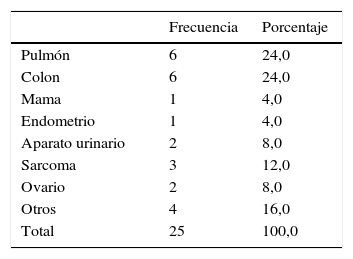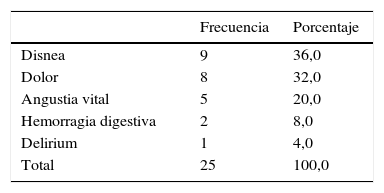Los objetivos del presente estudio fueron determinar la frecuencia de la sedación paliativa en nuestra unidad, conocer las características de los pacientes a los que se les aplicó y describir las medidas terapéuticas empleadas.
Material y métodoEstudio retrospectivo observacional de todos los pacientes que ingresaron y fallecieron en la Unidad de Cuidados Paliativos del Hospital Universitario Puerta del Mar de Cádiz entre el 1 de enero y el 31 de diciembre de 2013. Todos los pacientes atendidos fueron oncológicos. Los datos se obtuvieron mediante el análisis de historias clínicas. Se realizó un análisis descriptivo de las variables recogidas.
ResultadosIngresaron 290 pacientes, de los que fallecieron 92 (31,7%). Se aplicó tratamiento sedativo a 25 (27,2%). Alrededor de la mitad de estos fueron varones (52,0%) y su edad media fue 61,7 años (DE 10,2). La sintomatología refractaria más frecuente fue la disnea (36,0%). En todos los casos se empleó midazolam, solo o en combinación con levomepromacina, para conseguir la sedación.
ConclusionesEl perfil clínico del paciente que requiere sedación paliativa es el de un varón de 62 años de edad media, oncológico y con disnea como síntoma refractario. El midazolam es el fármaco más empleado y la vía de administración es intravenosa y subcutánea.
To determine the frequency of palliative sedation in our unit, to know the characteristics of the patients to whom it was applied and to describe the therapeutic measures that were employed.
Material and methodsObservational retrospective study of all patients who were admitted and died in the Palliative Care Unit of the Puerta del Mar University Hospital (Cádiz, Spain) between January 1st 2013 and December 31st 2013. All of them were oncology patients. The data were obtained from the medical records. A descriptive analysis of all the collected variables was performed.
ResultsA total of 290 patients were admitted; 92 died (31.7%). Among the latter, sedative treatment was applied to 25 (27.2%). About half of these were male (52.0%) and their mean age was 61.7 years (SD 10.2). The most common refractory symptom was dyspnea (36.0%). In all cases midazolam was used for sedation, alone or in combination with levomepromazine. Its route of administration was intravenous or subcutaneous.
ConclusionsThe clinical profile of patients requiring palliative sedation was: male, of 62 years of age, oncological and with dyspnea as refractory symptom. The most employed drug was midazolam.
Artículo
Comprando el artículo el PDF del mismo podrá ser descargado
Precio 19,34 €
Comprar ahora







